For architects and designers, it’s crucial to select the right building materials, from the foundation to the final decorative touches. Although every detail matters, one critical element is the facade surface. Concrete and brick may be durable with excellent acoustic insulation properties, but these materials are inevitably prone to damage.
Thankfully, at FILA Solutions, we have developed an innovative product to protect against the many environmental factors these materials face. Offering the ultimate protection for materials such as cement, concrete, and brick, CONCRETE HYDRO is a water-based, high-performance sealer that creates a barrier against water and other pollutants, to prevent damage and strengthen the structure itself.
Despite the fact that this is still a fairly new product, this ecological sealer has already been used for many projects worldwide and is a great choice for developers who are looking for a sustainable way to protect and preserve their chosen building materials. Surfaces such as cement and concrete are renowned for presenting many limitations, but this sealer can help reduce maintenance costs in many ways.
The limitations of concrete and brick
Over time, surfaces like concrete and brick are subject to degradation, as are cement and monolayer surfaces too. This is caused by various atmospheric agents like rain and UV rays, and this natural wear can give rise to a range of issues, including the following:
- Moisture, blackening, streaks, and rust
- Formation of efflorescences such as carbonates, sulfates and saltpetre
- Microorganisms such as algae, moulds and lichens
- Inorganic verdigris (the bright blue or green patina that forms on copper or brass by atmospheric agents)
- The appearance of cracks and breaks from wear
- Dusting on vertical surfaces made of cement and other derivatives (a problem that can also appear on monolayer, brick or artificial stone surfaces)
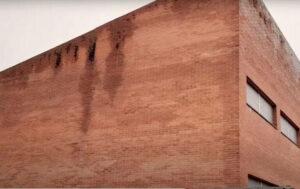
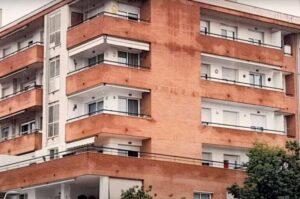
Exposed brick facades showing signs of damp spots and drips


Exposed cement and single-layer mortar facades experiencing issues with the presence of water and algae
To prevent any of the above issues from occurring, we highly recommend treating concrete and brick surfaces with FILA’s CONCRETE HYDRO. With this sealing treatment, you can rest assured that your surfaces will be preserved for years to come, whether they’re indoors or outside.
The solution for protecting façades and exterior facing walls
If you’re looking for a product that can effectively protect your building’s surfaces from the harmful effects of weathering, look no further than FILA’s CONCRETE HYDRO, a consolidating water-repellent protector. This innovative solution is specifically designed for use on facades, walls, and other decorative elements made from cement, concrete, and other materials with high absorption rates.
With its unique formula, CONCRETE HYDRO can penetrate the material and provide triple action to safeguard against damage:
1. Water-repellent action
One of this sealer’s standout features is its hydrophobic properties, which penetrate the material to repel and limit unattractive damp spots, blackened stains and lichens. This is essential for surfaces that are prone to cracking and deterioration over a period of time. Additionally, it effectively prevents the formation of efflorescence, including carbonates, sulphates, and saltpetre.


2. Consolidating action
By deeply penetrating the material, this sealer’s consolidating components provide enhanced strength, durability, and compaction, effectively preventing the material from deteriorating and becoming dusty in a short amount of time.

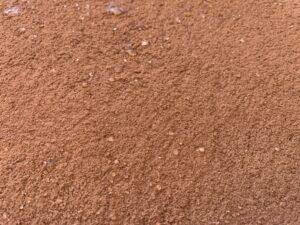
3. Breathable action
In addition to its protective properties, CONCRETE HYDRO works to maintain the breathability of a material without altering its appearance or creating a film. This makes it an ideal choice for architects and designers who want to maintain the natural beauty of cement, concrete, and brick surfaces while still protecting them from environmental factors.
As this sealer is also UV resistant, it will not yellow, another factor that helps it to maintain the original look of the surface. Moreover, surfaces treated with the product, such as cement and monolayer, can be painted seamlessly without any issues.
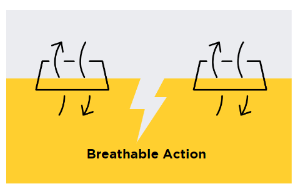
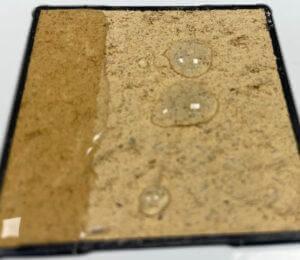
Water repellency analysis of CONCRETE HYDRO
Absorption test
To validate the effectiveness of CONCRETE HYDRO on concrete surfaces, the FILA Innovation Center conducted specific tests based on the RILEM method, an international standard for measuring properties and evaluating the performance and durability of various construction materials. The RILEM II.4 test method measures the speed at which water moves through porous materials and includes the Karsten tube test, a specific method for studying water absorption on vertical surfaces, such as exterior walls exposed to rain and atmospheric agents.
During the Karsten tube test, an L-shaped graduated glass instrument is fixed to the surface being tested with putty, and the rate of water level decrease over time is monitored. The initial column of water exerts a pressure on the surface equivalent to that of torrential raindrops driven by a 140 km/h wind.
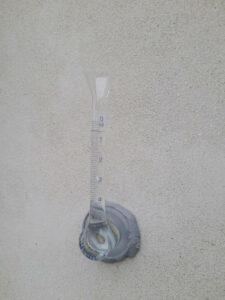
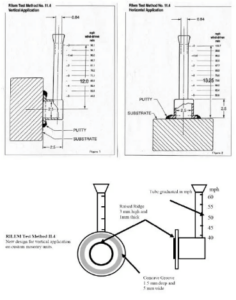
A Karsten tube positioned on a vertical concrete surface, and a dimension drawing that conforms
to the RILEM II.4 method
The results
To compare the effectiveness of CONCRETE HYDRO, a concrete surface treated with the product was analysed alongside an untreated area. The appropriate time intervals for testing depend on the porosity of the material, but in this case, 30 minutes was deemed enough, thanks to the high absorption of concrete and the immediate difference between the treated and untreated surface.
The graph shown demonstrates a significant reduction in water absorption for the area treated with CONCRETE HYDRO compared to the untreated material, with absorption levels approaching zero.

Where can CONCRETE HYDRO be applied?
CONCRETE HYDRO has been extensively tested and has been found to be effective in a wide range of environments:
Exterior concrete facades and interior walls
FILA’s CONCRETE HYDRO offers a reliable solution for protecting stylish and minimal concrete walls commonly found in modern homes and commercial buildings. This innovative product penetrates the material without altering the finish, providing a triple protective action against water and humidity damage, degradation, and the formation of unsightly stains, dust, and efflorescence.
This protection is especially important for concrete surfaces used for exterior facades, where they are exposed to extreme weather conditions and other pollutants. CONCRETE HYDRO also makes the material compact, resistant and durable so it can maintain its original appearance for years to come.

The treated area on the left does not allow water to penetrate the material’s interior, thereby maintaining its appearance and integrity
Exterior rendered facades
FILA’s CONCRETE HYDRO is a powerful solution that can protect external rendering, commonly seen on modern homes and commercial buildings. The product acts by penetrating deep into the material and repelling water to prevent unsightly stains and the formation of efflorescence such as carbonates, sulphates, and saltpetre.


Single-layer mortar facades; one with protection from CONCRETE HYDRO, and the other without
Exposed brick facades and walls
Brick is a common building material that can withstand extreme weather conditions, is readily available and very easy to work with. It is, however, incredibly porous and prone to the formation of efflorescence, so to mitigate erosion, brick often needs a sealing treatment.
In terms of enhancing the longevity of brick, CONCRETE HYDRO can be applied to prevent the growth of mould, algae, and organic patinas. The sealer reduces the need for frequent cleaning and maintenance, which is particularly important for those surfaces which are exposed to pollutants on a daily basis.
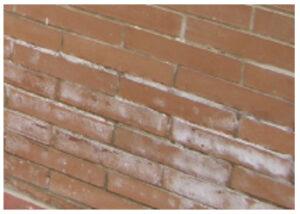

An efflorescence problem (L) and brick facade (R)
Decorative cement and concrete
If you’re looking to add some decorative elements to your construction project, concrete can be used to create handrails, balustrades, and pillars. To ensure their long-term aesthetic appeal, they can also be protected with CONCRETE HYDRO which will keep their beauty intact for years to come.
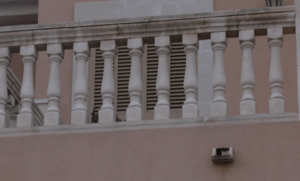

A balustrade in precast concrete shown with and without protection
artificial stone
Artificial stone is a man-made substance that imitates the visual and textural features of natural stone. This versatile material is widely used in construction, serving as either the primary building material or as a cladding for interior and exterior walls, facades, and other surfaces.
By applying CONCRETE HYDRO to artificial stone, its durability and resistance to wear and tear can be maintained over time, ensuring that decorative elements retain their charm and functionality.
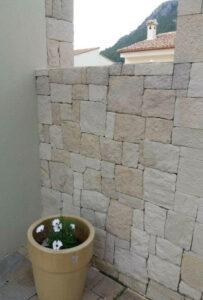
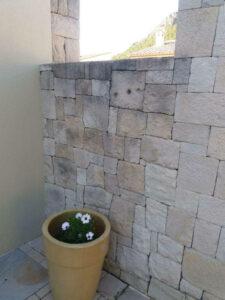
A before and after of artificial stone, cleaned with ALGACID and sealed with CONCRETE HYDRO for protection
Other materials
A versatile sealer, CONCRETE HYDRO, is suitable for both indoor and outdoor applications. It has also been specifically designed to protect all of the above, but here are some other examples of where it can be used:
- Exterior facades with thermal insulating systems (SATE)
- Facades and small walls in reconstructed stone
- Concrete pool edges
- Interlocking pavers installed in areas not exposed to organic stains
- Tuff structures
How to apply CONCRETE HYDRO
Applying CONCRETE HYDRO is a straightforward process; the surface just needs to be clean and dry beforehand. It can also be applied with a brush, but for vertical surfaces, we would recommend this is done with an airless system. Once applied, CONCRETE HYDRO dries quickly and starts its protecting effect, ensuring that surfaces stay protected even if exposed to harsh sunlight or water after application. Just 5 litres of product can also treat up to 40 square metres, depending on the absorbency of the material itself.
Furthermore, the sealer provides surfaces with a natural finish, preserving their original colour and texture. This makes it an excellent option for architects and designers who want to retain the material’s natural beauty while also safeguarding it from environmental damage.

Application of CONCRETE HYDRO with an airless system
Preventive measures
There are certain precautions that need to be taken before applying this sealer. First, a patch test should be performed to ensure that there are no changes in colour on the surface. It is also recommended to avoid using the product if there is a chance of rain, if the surface has a buildup of condensation, or if it is exposed to direct sunlight.
Furthermore, it is important to avoid applying the sealer on new polished natural stones like granite and marble, glass, wood, and metal, as it may modify them. In addition, keep in mind that this sealer will not protect against acid aggression, but it will help prevent surfaces from deteriorating due to atmospheric agents.
The impact of CONCRETE HYDRO on sustainable projects
At FILA, ecological solutions such as CONCRETE HYDRO are developed with a priority on sustainability and environmental responsibility. This water-based protector is free from solvents and contains low VOCs, making it safe for both the environment and for the contractor to use.
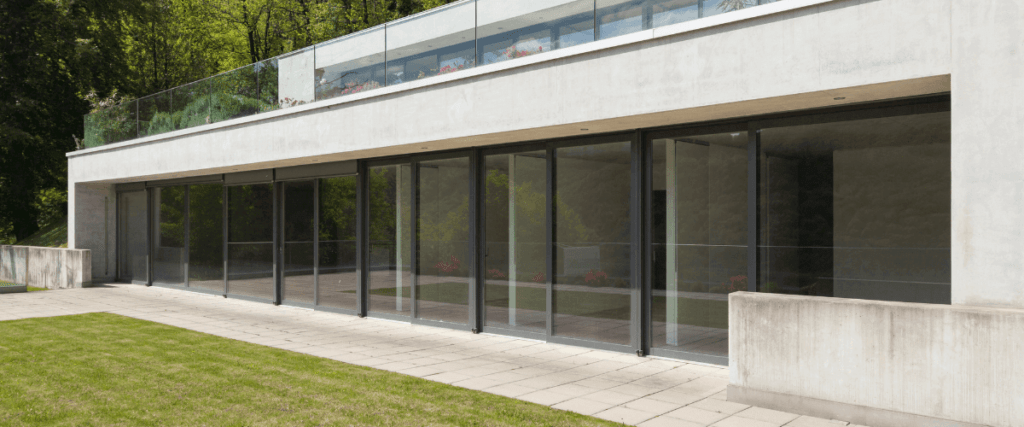
Indoor Air Comfort Gold
Thanks to its high environmental standards, this water-based sealer has also earned Indoor Air Comfort Gold certification, an international label that recognises low VOC emissions in construction materials. CONCRETE HYDRO can also help construction professionals obtain LEED® and BREEAM® credits, making it an ideal choice for contractors who are committed to creating sustainable buildings that are environmentally friendly.

Indoor Air Comfort Gold certified label
Other certifications for CONCRETE HYDRO
CONCRETE HYDRO has obtained Eurofins certification by meeting the rigorous prerequisites, which include mandatory national regulations like FrenchA+, CAM Edlilizia, Belgian Regulation, AgBB, and, as mentioned, innovative evaluation systems for environmental sustainability such as LEED, BREEAM, and WELL.

French VOC FREE label
Discover the sealer that completes the FILA ‘CONCRETE’ product line
With the addition of CONCRETE HYDRO, our range of consolidating sealers now cover a broader spectrum of materials. So, if you’re looking to protect concrete, cement, or brick, this particular sealer will repel pollutants whilst ensuring the surface remains breathable.
Overall, CONCRETE HYDRO is a practical choice for architects and designers seeking outstanding surface protection. With no specialised equipment needed, this sealer will give any project ‘the edge’. To find out more, speak to our technical team or download the datasheet here.
